Bankruptcies, legal tangles create challenges.
Foundation provides some stability
Voters in the North Sonoma County Hospital District
(which stretches from Cloverdale to Windsor) are being asked to
approve a $150 per year parcel tax for Healdsburg District Hospital
in a special election on April 13. If approved, the tax will
replace an $85 parcel tax that voters approved in Nov. 2001, when
the hospital district was formed. According to hospital leaders,
the publicly-owned hospital will not last out the year without the
extra money. Between now and the election, we are exploring the
history of the hospital, what has led to this crossroads, the
current structure of the hospital district, and what may happen if
the measure passes, or if it fails.
by RAY HOLLEY, Staff Writer
While exploring how Healdsburg District Hospital came to be
where it is now – asking the community once again to step forward
and save it from closure – it becomes clear that the hospital does
not operate in a vacuum.
The 21st century American health care system is widely agreed to
be in disarray – more and more money goes in, yet doctors,
hospitals and patients make do with less and less. This series does
not intend to address national or even statewide healthcare issues,
but we will take a look at how other local entities have affected
Healdsburg Hospital, both for good and not so good.
Nuestro Hospital, Inc.
Six years ago this week, Healdsburg held a town meeting at the
Villa Chanticleer, to discuss how to respond to the news that
Columbia/HCA, a giant healthcare conglomerate, was going to shut
down Healdsburg Hospital in six months, unless a buyer stepped
forward. Dr. Dan Rose, a Healdsburg physician who had just sold his
practice and was looking forward to retirement, emerged as a
leader.
“We decided that we just couldn’t let this little hospital go
down without a fight,” said Rose, who formed a non-profit
corporation, Nuestro Hospital, with attorney Ed Wilson and fellow
physician Steve Vargas.
The city of Healdsburg put up $15,000 for a firm called Westport
Health Care Consulting Group to conduct a financial feasibility
study. According to Rose, the Westport study “concluded that it
would work,” so Nuestro recruited a larger board and began
negotiations.
By fall, they had settled on $4 million as the purchase price,
and the deal was done in November.
The city allowed Nuestro to use its tax-exempt status to issue
$6.2 million in bonds. The money was used to buy the hospital,
upgrade equipment, and provide startup capital.
Nuestro never broke even. Rose and Chief Executive Officer Ed
Bland blamed the problems partly on bad information. The Chief
Financial Officer Raul Miranda “kept bringing us bad numbers,” said
Rose. “We kept questioning them, and it turned out they were dead
wrong.”
When Nuestro took drastic steps in March 2001, closing the
intensive care unit, the maternity ward, and laying off workers,
Rose said that it was a difficult choice but that it helped the
hospital survive. “We were losing $120,000 a month before
restructuring, and $50,000 a month after,” he said.
Nuestro then organized a parcel tax measure for the Nov. 2001
ballot, along with a companion measure that would create a hospital
district stretching from Windsor to Cloverdale. The measures passed
overwhelmingly, and the North Sonoma County Hospital District took
over on April 1, 2002.
The hospital was acquired by the process known as eminent domain
(also known as condemnation), a legal tool used by public agencies
to acquire private property for public use. Eminent domain is
commonly used for public right-of-way issues. For example, the city
of Santa Rosa used it for dozens of private parcels that were
affected by the Geysers pipeline project.
By acquiring the hospital in this way, the new North Sonoma
County Hospital District was able to start with a clean slate. It
commissioned an appraisal of the facility, and legally forced
Nuestro to sell it for that amount, approximately $2.65
million.
Left with $4.5 million in assets and $8 million in debts,
Nuestro declared bankruptcy, which has not yet been resolved.
Two factors, the bankruptcy and the difference between a 1998
appraisal for $4 million and a 2002 appraisal for $2.65 million,
have combined to create lingering legal problems for Healdsburg
District Hospital.
According to Dan Hull, Chief Financial Officer for the hospital,
the Nuestro bankruptcy trustee has been “very adversarial” in
dealing with the district. “They’ve questioned every dollar,” said
Hull. “They’ve been a big pain in the neck.”
The district, for example, had to hire an accounting firm to
prepare an audit of its MediCal and Medicare cost reports. Hull
explained that, since the transaction with the auditor took place
within 90 days of the bankruptcy, the trustee, Jeffry Locke, was
able to force the accounting firm to refund the payment, damaging
the relationship between the firm and the district. “That sort of
thing has caused a lot of heartburn,” said Hull. (At press time,
Locke had not responded to telephone and e-mail attempts to contact
him for this article.)
In other cases, local vendors didn’t want to do business with
the hospital district because the vendors haven’t been paid by
Nuestro. “We have to explain that we’re a different entity,” said
Hull.
Hull said that much of the day-to-day problems with the Nuestro
bankruptcy are long past, but he sees a lingering perception of
problems and mismanagement. “We still struggle with people
identifying us with that history,” he said, “and we have had to
become sensitized to people’s concerns.”
Hull said, “people often ask me – how come the first parcel tax
didn’t work? I have to say I don’t know, I wasn’t there at the
time. But I recognize that there are those concerns.”
The holders of $6.2 million in Nuestro bonds were not happy with
the eminent domain arrangement, and have filed suit to challenge
it.
Jim Phillips, a vice- president at Van Kampen Securities, which
is holding the Nuestro bonds, refused to comment for this article,
citing a company policy against speaking to the press.
Bill Madison, an attorney who studied the original bond
transaction on behalf of the city, said he was surprised at the
eminent domain tactic. “It was definitely unusual,” he said.
Madison said a similar tactic was used by a school district in
New Jersey to acquire a school that it had been leasing, and the
resulting transaction caused such an uproar that bond insurers now
require contract covenants preventing such an action.
According to Hull, the bondholders challenged the legality of
the eminent domain approach, and the lower appraised value. He said
the legality issue has been resolved, and that the primary
contention now is over the fair market value of the hospital. This
means that the actual ownership of the hospital is under legal
scrutiny, which is one reason why the district has not mortgaged
the land to help pay the bills. “The title is being contested,”
said Hull.
Rose said he feels confident that they will settle. “The
bondholders are very sophisticated people,” he said. “They know
there’s only so much money – you can’t get blood out of a
turnip.”
Health Plan of the Redwoods
Another major player in the hospital story is the now-defunct
Health Plan of the Redwoods. The insurer declared bankruptcy in May
2002 and closed its doors six months later. At the time, the new
hospital district was just a few weeks old.
Hull said that HPR made up 41 percent of the hospital’s
“non-MediCal, non-Medicare” patients,” or about a quarter of the
total.
“There was almost an over-reliance on that contract,” said Hull.
Bland and Rose had relied on the hopes of a favorable renegotiation
with HPR to lift Healdsburg Hospital.
When HPR went away, so did 78,000 patients in the North Bay,
many of them to other health plans like HealthNet that do not pay
as well.
Hull says that, little by little, the losses are being regained.
New contracts with other plans like Blue Cross and Blue Shield are
paying better, and overall reimbursements are on the upswing. “We
have more than recouped the patients we lost,” he said.
Another major HPR impact was cash flow. As the hospital’s major
source of income, when HPR froze its payables in early 2002,
Healdsburg got hit hard by cash flow problems.
Hull said that about $430,000 was owed to Healdsburg by HPR, and
after contractual discounts, it amounted to approximately
$200,000.
Another entity stepped up to help with the loss.
Healthcare Foundation Northern Sonoma County
This non-profit charitable foundation has its roots in the
Healdsburg Hospital Foundation, founded by Rose and attorney Henry
Hersch to provide assistance to the struggling hospital.
The previous foundation is still legally intact, said Rose, but
is not active.
As it became clear that the hospital would become a public
entity, the foundation’s volunteer board of directors decided to
become more independent.
They formed the Northern Sonoma County Healthcare Foundation
(and changed the name recently to Healthcare Foundation Northern
Sonoma County).
The foundation has contributed more than $500,000 to the new
Alliance Medical Center, and more than $300,000 to Healdsburg
Hospital, mostly for equipment. According to foundation President
Alson Kemp, it also has more than $1 million “in the bank” to help
with the hospital’s projected Emergency Department remodel.
The foundation also purchased the HPR bankruptcy debt, for
$100,000, which was the best guess of how much the hospital would
realize from the bankruptcy. So far, the foundation has received
$87,000 back from HPR. The cash helped the hospital make a
payroll.
As a general rule, the foundation does not supply the hospital
with operating capital. Why not? Kemp said, “it is a belief of the
majority of the foundation board, and many of our donors, that it
is up to the general community and Healdsburg District Hospital
itself to meet operating costs, that donating operating costs might
lessen the attention paid to efficient operations.”
Kemp concedes that not every member of the foundation board
agrees with that philosophy, but it has been the overall direction
since the foundation began.
The foundation continues to help the hospital with equipment
purchases, especially when it can be shown that the new equipment
helps make the facility more efficient or profitable.
Hull admits that the foundation can be aggressive in its
questioning of how he’s running things. “They can be very critical
at times, but I don’t resent that. It helps us clear the
hurdles.”
The foundation has also budgeted $20,000 for “educational
mailings” to voters in the district about the upcoming parcel tax
election.
Next week the series continues. We will discuss the hospital’s
emergency department, as well as who uses the hospital and why.








